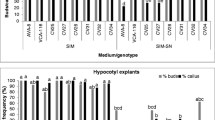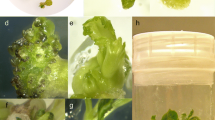Abstract
The application of modern biotechnology for improvement of chili pepper productivity requires an efficient in vitro plant regeneration protocol. In this study, a reliable protocol was developed for the in vitro regeneration of four types of chili, Capsicum annuum var. annuum (Jalapeño and Serrano), C. annuum var. glabriusculum/aviculare (Piquin), and C. chinense (Habanero) by direct organogenesis using three different explants (cotyledon, hypocotyls, and embryo) and three induction media. All evaluated culture media promoted the formation of adventitious shoots. When embryos or hypocotyls were used as explants, morphologically normal adventitious shoots developed, while culturing cotyledons resulted in nonelongating rosette-shaped shoots. The highest in vitro regeneration efficiency (14.6 shoots per explant) was achieved when Habanero chili hypocotyls were grown on Murashige and Skoog medium containing 1.7 μM indole-3-acetic acid and 22.2 μM N6-benzyladenine. This regeneration rate is higher than that obtained in previous reports. Regenerated plants were ready to be transferred to the greenhouse 13 wk after the explant culture. An evaluation carried out under greenhouse conditions showed differences in agronomic performance between in vitro regenerated plants and plants developed from seeds with the magnitude of the differences depending on the genotype being studied.

Similar content being viewed by others
References
Agrawal S.; Chandra N.; Kothari S.-L. Plant regeneration in tissue cultures of pepper (Capsicum annuum L. cv. Mathania). Plant Cell Tiss. Org. Cult. 16: 47–55; 1989. doi:10.1007/BF00044071.
Aguado-Santacruz G. A.; Martínez-Castillo A.; Moreno-Gómez B.; Peña-Mosqueda D. Cultivo de tejidos vegetales. In: Aguado-Santacruz G. A. (ed) XVI Jornada de ingeniería bioquímica. INIFAP, Unidad de Biotecnología-Instituto Tecnológico de Celaya, Celaya, Gto. Mex, p 51 p; 2004.
Amzad H.-M.; Konisho K.; Minami M.; Nemoto K. Somaclonal variation of regenerated plants in chili pepper (Capsicum annuum L). Euphytica 130: 233–239; 2003. doi:10.1023/A:1022856725794.
Basra A. S. Seed quality; basic mechanisms and agricultural implications. Food Products, New York1995.
Binzel M.-L.; Sankhla N.; Joshi S.; Sankhla D. In vitro regeneration in chili pepper (Capsicum annuum L.) from ‘half-seed explants’. Plant Growth Regul. 20: 287–293; 1996. doi:10.1007/BF00043320.
Cárdenas-Avila M.-L.; Verde-Star J.; Villarreal J.; Valadés M.-C.; Maiti R.-K.; Morales M.-R In vitro tissue culture of wild chili «chile piquín» (Capsicum annuum L. var. aviculare (Dierb.) D’Arcy & Eshbaugh): an alternative method for propagation. Phyton 60: 99–102; 1997.
Cardone S.; Olmos S.; Echenique V Métodos para generar variabilidad. In: Echenique V.; Rubinstein C.; Mroginski L. (eds) Biotecnología y mejoramiento vegetal. INTA, Argentina, pp 81–96; 2004.
Castillo-Martínez, C.-R. Transformación genética de Paulonia elongata mediada por Agrobacterium tumefaciens y por biobalistica. Ph. D. thesis, Colegio de Postgraduados, México; 2007.
Dabauza M.; Peña L High efficiency organogenesis in sweet pepper (Capsicum annuum L.) tissues from different seedling explants. Plant Growth Regul. 33: 221–229; 2001. doi:10.1023/A:1017585407870.
Deepu M.; Doijode S.-D.; Reddy K.-M Correlation and path coefficient analysis in five species of Capsicum. Capsicum Eggplant Newsl. 23: 57–60; 2004.
Estrada-Luna A.-A.; Davies F.-T.; Egilla J.-N Physiological changes and growth of micropropagated chile ancho pepper plantlets during acclimatization and post-acclimatization. Plant Cell Tiss. Org. Cult. 66: 17–24; 2001. doi:10.1023/A:1010606430060.
Ezura H Micropropagation of Capsicum species (pepper). In: Bajaj Y. P. S. (ed) Biotechnology in agriculture and forestry high-tech and micropropagation, vol 39. Springer, Heidelberg, pp 48–59; 1997.
FAOSTAT. Food and Agriculture Organization of the United Nations. Database results. http://faostat.fao.org. Cited 18 Jun 2008; 2006.
Hernández-Verdugo S.; Guevara-González R.-G.; Rivera-Bustamante R.-F.; Vázquez-Yanez C.; Oyama K Los parientes silvestres del chile (Capsicum spp.) como recursos genéticos. Bol. Soc. Bot. 62: 171–181; 1998.
Husain S.; Jain A.; Kothari S.-L. Phenylacetic acid improves bud elongation and in vitro plant regeneration efficiency in Capsicum annuum L. Plant Cell Rep. 19: 64–68; 1999. doi:10.1007/s002990050711.
Joshi A.; Kothari S.-L High copper levels in the medium improves shoot bud differentiation and elongation from the cultured cotyledons of Capsicum annuum L. Plant Cell Tiss. Org. Cult. 88: 127–133; 2007. doi:10.1007/s11240-006-9171-6.
Kaparakis G.; Alderson P.-G Differential callus type formation by auxins and cytokinin in in vitro cultures of pepper (Capsicum annuum L.). Plant BioSyst. 137: 275–280; 2003. doi:10.1080/11263500312331351521.
Kelly A. F Seed production of agricultural crops. Longman Scientific and Technical. Wiley, New York1988.
Kintzios S.; Drossopoulos J.-B.; Lymperopoulos C.-H Effect of vitamins and inorganic micronutrients on callus growth and somatic embryogenesis from leaves of chilli pepper. Plant Cell Tiss. Org. Cult. 67: 55–62; 2001. doi:10.1023/A:1011610413177.
Kumar B.-K.; Munshi A.-D.; Joshi S.; Kaur C.-H Correlation and path coefficient analysis for yield and biochemical characters in chilli (Capsicum annuum L.). Capsicum Eggplant Newsl. 22: 67–70; 2003.
Kumar V.; Gururaj H.-B.; Narasimha B.-C.; Giridhar P.; Ravishankar G.-A. Direct shoot organogenesis on shoot apex from seedling explants of Capsicum annuum L. Sci. Hort. 106: 237–246; 2005. doi:10.1016/j.scienta.2005.02.021.
López-Encinas, C. Juvenilidad y rejuvenecimiento de plantas cultivadas in vitro. http://www.encuentros.uma.es/encuentros27/27juvenil.html. Cited 13 Jul 2007; 2007.
López-Puc G.; Canto-Flick A.; Barredo-Pool F.; Zapata-Castillo P.; Montalvo-Peniche M.-C.; Barahona-Pérez F.; Santana-Buzzy N Direct somatic embryogenesis: a highly efficient protocol for in vitro regeneration of habanero pepper (Capsicum chinense jacq.). Hort. Sci. 41: 1645–1650; 2006.
Murashige T.; Skoog F A revised medium for rapid growth and bioassays with tobacco tissue cultures. Physiol. Plant 15: 473–497; 1962. doi:10.1111/j.1399-3054.1962.tb08052.x.
Nandadevi; Hosamani R.-M Variability, correlation and path analysis in kharif-grown chilli (Capsicum annuum L.) genotypes for different characters. Capsicum Eggplant Newsl. 22: 43–46; 2003.
Nuez F.; Gil-Ortega R.; Costa J. El cultivo de pimientos, chiles y ajíes. Mundi-Prensa, México D.F1996.
Ochoa-Alejo N.; Ireta-Moreno L Cultivar differences in shoot-forming capacity of hypocotyl tissues of chilli pepper (Capsicum annuum L.) cultured in vitro. Sci. Hort. 42: 21–28; 1990. doi:10.1016/0304-4238(90)90144-4.
Peddaboina V.; Thamidala C.; Subhash K Selection of atrazine-resistant plants by in vitro mutagenesis in pepper (Capsicum annuum). Plant Cell Tiss. Org. Cult. 83: 75–82; 2005. doi:10.1007/s11240-005-2678-4.
Pinzón, L. Aspectos fisiológicos, anatómicos y morfológicos de la recalcitrancia del cultivo in vitro del chile habanero (Capsicum chinense Jacq.). Ph. D. thesis, Colegio de Postgraduados, México; 2007.
Prakash A.-H.; Sankara K.; Kumar M Plant regeneration from protoplasts of Capsicum annuum L. cv. California Wonder. J. Biosci. 22: 339–344; 1997. doi:10.1007/BF02703236.
Ramírez-Malagón R.; Ochoa-Alejo N An improved and reliable chili pepper (Capsicum annuum L.) plant regeneration method. Plant Cell Rep. 16: 226–231; 1996. doi:10.1007/BF01890873.
Robledo-Paz A.; Carrillo-Castañeda G Regeneración in vitro de plantas de chile (Capsicum annuum L) mediante cultivo de cotiledones e hipocótilos. Rev. Fitotec. Mex. 27: 121–126; 2004.
Sanatombi K.; Sharma G.-J In vitro regeneration and mass multiplication of Capsicum annuum L. Agri. Environ. 4: 205–208; 2006.
Santana-Buzzy N.; Canto-Flick A.; Barahona-Pérez F.; Montalvo-Peniche M.-C.; Zapata-Castillo P.-Y.; Solís-Ruíz A.; Zaldívar-Collí A.; Gutiérrez-Alonso O.; Miranda-Ham M.-L Regeneration of habanero pepper (Capsicum chinense Jacq.) via organogenesis. Hort. Sci. 40: 1829–1831; 2005.
Santana-Buzzy N.; Canto-Flick A.; Iglesias-Andreu L.-G.; Montalvo-Peniche M.-C.; López-Puc G.; Barahona-Pérez F Improvement of in vitro culturing of habanero pepper by inhibition of ethylene effects. Hort. Sci. 41: 405–409; 2006.
Sripichit P.; Nawata E.; Shigenaga S In vitro shoot-forming capacity of cotyledon explants in red pepper (Capsicum annuum L. cv. Yatsufusa). Jap. J. Breed 37: 133–142; 1987.
Steel R.-D.; Torrie J. H. Bioestadistica: principios y procedimientos. McGraw-Hill, México1992.
Steinitz B.; Küsek M.; Tabib Y.; Paran I.; Zelcer A. Pepper (Capsicum annuum L.) regenerants obtained by direct somatic embryogenesis fail to develop a shoot. In Vitro Cell Dev. Biol. Plant 39: 296–303; 2003. doi:10.1079/IVP2002405.
Valera-Montero L.; Ochoa-Alejo N A novel approach for chili pepper (Capsicum annuum L.) plant regeneration: shoot induction in rooted hypocotyls. Plant Sci. 84: 215–219; 1992. doi:10.1016/0168-9452(92)90137-B.
Valera-Montero L.; Phillips G.-C Long-lasting Capsicum baccatum ‘organogenic callus’ formation. In Vitro Cell Dev. Biol. Plant 41: 470–476; 2005. doi:10.1079/IVP2005648.
Acknowledgement
The authors would like to express their gratitude to The National Council for Science and Technology (CONACYT, Mexico) for the scholarship awarded to M.G.V.B. (number 184879).
Author information
Authors and Affiliations
Corresponding author
Additional information
Editor: N. Ochoa-Alejo
Rights and permissions
About this article
Cite this article
Valadez-Bustos, M.G., Aguado-Santacruz, G.A., Carrillo-Castañeda, G. et al. In vitro propagation and agronomic performance of regenerated chili pepper (Capsicum spp.) plants from commercially important genotypes. In Vitro Cell.Dev.Biol.-Plant 45, 650–658 (2009). https://doi.org/10.1007/s11627-009-9193-y
Received:
Accepted:
Published:
Issue Date:
DOI: https://doi.org/10.1007/s11627-009-9193-y




